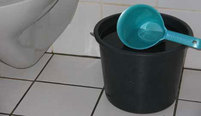Mercury Drug, Colon Street, Dumaguete City

However, should you need to go to a “comfort station” in a public place, that’s a whole other matter. Some restaurants that cater to a lot of foreigners have “bathroom tissue,” but you’re advised to bring your own just in case. Most often, you’ll need to do what the locals do and use the tabo, a small dipper with a handle and a water pail to wash yourself.
 photo: pinoyexchange.com
photo: pinoyexchange.com Ask a Filipino why they don’t use toilet paper, and you’ll probably hear a commonly repeated assumption: the Philippines doesn’t have the tree or paper industry for it, which isn’t completely true. The Philippines has a significant forestry industry. Most of their tree harvest and wood production, however, goes into making furniture and other wood-based manufactured items, not into pulp for tissue paper. According to the Philippine Forest Management Bureau, in 2012, for example, the country exported products worth about $52 billion. But they also still imported paper tissue products, including toilet paper, worth $24 million. So both the scarcity of toilet paper manufacturing and the high price (for most Filipinos) of an imported good definitely explain part of the low TP use.
But the question itself is culturally biased toward toilet paper usage. Maybe the question to ask is: why use toilet paper when washing with soap and water has been the accepted practice for centuries? Is it any more sanitary than wiping? Here's where most locals will reveal that in fact, the tabo is perfectly sanitary. In other words, why wipe when you can wash?
Ultimately, using toilet paper is, pardon the pun, a bit wasteful. It’s no surprise that on average Americans have the highest tissue and toilet paper usage per capita in the world.
Between our “irresponsible amount of napkins” used on the front end of the digestive process (thank you, Jon Stewart, I’m gonna miss you so much), the crazy amount of paper towels we use, and our wasteful waste practices, well, maybe the piped in soundtrack of many public restrooms and restaurants should be the sound of chainsaws cutting down trees.
Am I getting too pedantic? Don't get me wrong, I'm still using paper products, even in the land of the tabo, but I do pride myself on getting through a meal now by only using one measly thin napkin.
In a tropical place like the Philippines, except for printing books and important documents and doing homework, paper is pretty over-rated. With the high humidity and the likelihood of little insects crawling into paper products, at least with food packaging, one soon realizes the benefits of plastic.
Don’t think the low paper use here is some “save the planet” ecological instinct in the Filipino psyche. While Filipinos skimp on paper, they are absolutely bananas for plastic bags. Often to get one’s purchase out of a store in the Philippines, the stuff goes in a bag in a bag, and then inside another bag. Never mind paper saving, the plastic bag is ubiquitous.
The one time I seriously felt I was breaking a cultural taboo was when I told the woman at the bakery register that I didn't need a plastic bag for the ube roll I was buying. I tried to explain that I was just going to sit at a table two two steps away and eat it. "No, thank you, I don't need a bag," I politely said.
She already had the plastic bag open and read and it positively threw her. No, I insisted, just leave the roll on the tray, I'll be okay. She still looked confused, a little offended. "No bag?" she asked.
I tried to smile politely, but didn't know what to do. "Do you have a paper napkin?" I asked.
One wonders what the Filipinos did to store their food before the plastic bag. Oh yeah, they had ceramic bowls and jars from China. The Chinese ceramics trade. Here we are, back at China.
 RSS Feed
RSS Feed